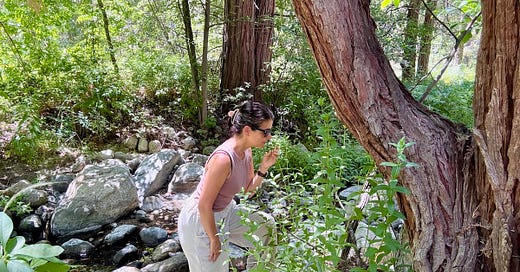What I Learned Foraging in the Forest
Whether you live in the woods or the city, this practice is for you.
Dear Friends,
Have you ever foraged?
Not just gathered herbs or berries, but walked slowly enough to notice what the land is offering and tune in to listen, learn, and remember.
I hadn’t. Not really. Not until this morning, beside a mountain creek in Idyllwild, where I crushed a wild mint leaf between my fingers and breathed in a scent that instantly lifted me.
Ever since moving from Los Angeles two hours away to this quaint mountain village, I've wanted to learn how to forage the abundant life around us consciously. I can use an app or a book, but I learn better when guided in person.
Today, I finally went on a two-hour foraging adventure with Tricia, a local medicine woman and artist who has lived in these sacred Cahuilla Mountain people lands for over thirty years. She was taught directly by the keepers of the land to identify the wild plants, trees, fruits, flowers, herbs, and grains that flourish here without human tending.
Our small group met by Strawberry Creek, where Tricia knelt beside a patch of what looked like ordinary weeds and showed us how to recognize wild mint by crushing a leaf between our fingers. The sharp, clean scent rose immediately, unmistakable once you knew what to look for. As we walked along the creek's path, she pointed out the subtle differences between edible and toxic plants, teaching us to spot wild blackberry canes heavy with fruit, the distinctive serrated leaves of stinging nettle, and the wild concord grape vines with their heart-shaped leaves, already heavy with deep purple clusters.
You don’t need to live in a mountain village to feel this connection. Wherever you are, the earth waits quietly to meet you.
So much filled my awareness during those two hours. Beyond the plants themselves, I absorbed the teachings they offered like sacred knowledge held in root and leaf. What stayed with me most wasn’t just the names or uses of each plant, but the way this experience reminded me that grounded living really means connection with place, rhythm, and purpose.
Even if you live in the heart of a city, this kind of practice remains available to you. You might explore the edible weeds growing through sidewalk cracks, learn about the fruit trees planted in public spaces, or discover which herbs flourish in community gardens. The practice lives not just in what you gather but in the slowing down, the noticing, the willingness to step outside the rhythm of hustle and into the slower, steadier rhythm of the earth.
Here are the insights I'm carrying with me:
1. Respect comes first.
You don't begin by taking. You begin by noticing, asking permission, and offering thanks. Tricia reminded us that every plant carries its own spirit and purpose. Foraging consciously means entering into a relationship rather than a transaction.
2. Abundance often hides in plain sight.
A single wild strawberry tucked beneath heart-shaped leaves. Bitter greens with healing bite. Elderflower scent curling through the air. Life constantly offers its gifts. The question is: am I moving slowly enough to receive them?
3. Learning becomes a form of belonging.
When you know the names of the plants where you walk each day, when you understand their stories and seasons, you root yourself more deeply in the land. Through this knowledge, I begin to understand that I am not separate from this place but participating in its cycles.
4. Self-sufficiency is participation, not isolation.
This experience was about reentering the world with greater awareness. Earth already provides so much when we learn how to be in relationship with her. True sufficiency comes from remembering our ancestors once lived in rhythm with the land and trusting that rhythm again.
5. This is a practice in slowing down.
Whether in a forest, a city park, or my own backyard, I can choose to walk more slowly, to pay closer attention, to look for what nourishes my spirit as much as my body.
Foraging reminded me that the earth is always in conversation with us, offering guidance, nourishment, and relationship to those willing to pay attention. And maybe the invitation at the heart of it all is to live more connected, more awake, and more attuned to the rhythms that have always been here.
What might shift for you if, just for today, you moved through your surroundings with the quiet intention to notice what's already offering itself to you? Whether it's a plant, a scent, a memory, or a moment of stillness…start there. Let it speak. Let it guide you home.
If this resonated, consider liking or sharing it with a friend. And let me know in the comments—what’s the last thing nature taught you?
I love hearing from you.
With love,
Ana 🌹








I went foraging in Asheville and it was such a cool experience to learn how much we have direct access to. I’m still too nervous to do it on my own but would love to do it again with a guide